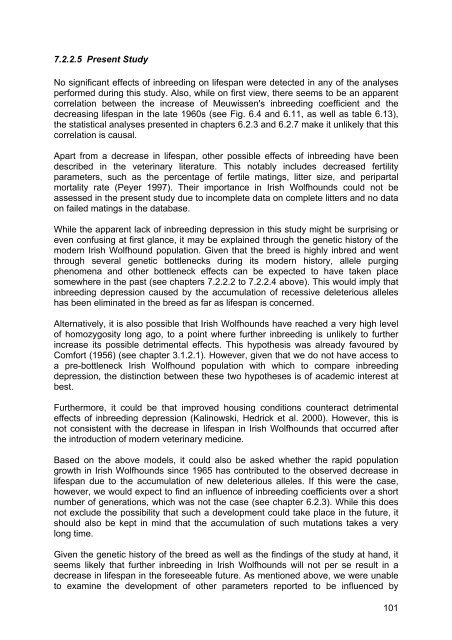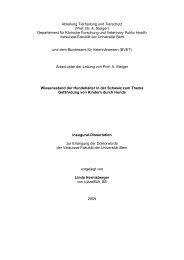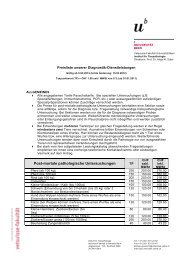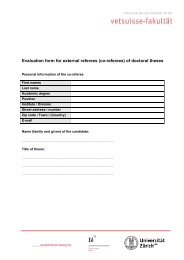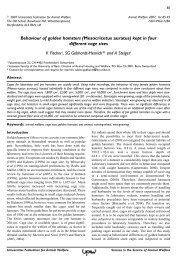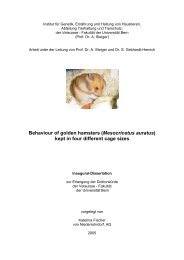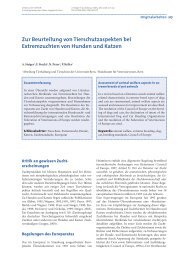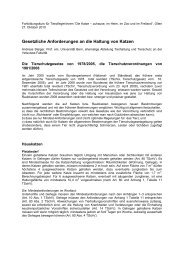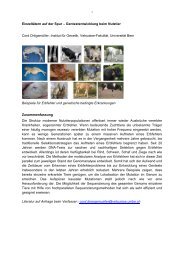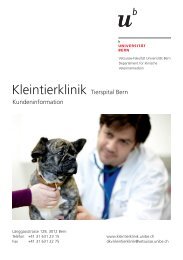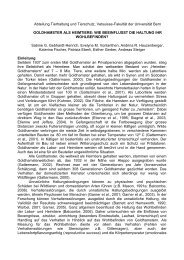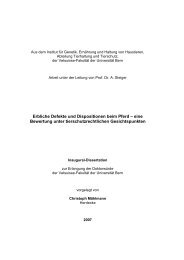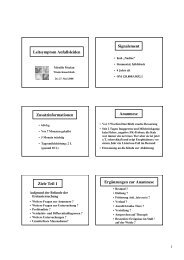Lifespan and Causes of Death in the Irish Wolfhound - Vetsuisse ...
Lifespan and Causes of Death in the Irish Wolfhound - Vetsuisse ...
Lifespan and Causes of Death in the Irish Wolfhound - Vetsuisse ...
You also want an ePaper? Increase the reach of your titles
YUMPU automatically turns print PDFs into web optimized ePapers that Google loves.
7.2.2.5 Present Study<br />
No significant effects <strong>of</strong> <strong>in</strong>breed<strong>in</strong>g on lifespan were detected <strong>in</strong> any <strong>of</strong> <strong>the</strong> analyses<br />
performed dur<strong>in</strong>g this study. Also, while on first view, <strong>the</strong>re seems to be an apparent<br />
correlation between <strong>the</strong> <strong>in</strong>crease <strong>of</strong> Meuwissen's <strong>in</strong>breed<strong>in</strong>g coefficient <strong>and</strong> <strong>the</strong><br />
decreas<strong>in</strong>g lifespan <strong>in</strong> <strong>the</strong> late 1960s (see Fig. 6.4 <strong>and</strong> 6.11, as well as table 6.13),<br />
<strong>the</strong> statistical analyses presented <strong>in</strong> chapters 6.2.3 <strong>and</strong> 6.2.7 make it unlikely that this<br />
correlation is causal.<br />
Apart from a decrease <strong>in</strong> lifespan, o<strong>the</strong>r possible effects <strong>of</strong> <strong>in</strong>breed<strong>in</strong>g have been<br />
described <strong>in</strong> <strong>the</strong> veter<strong>in</strong>ary literature. This notably <strong>in</strong>cludes decreased fertility<br />
parameters, such as <strong>the</strong> percentage <strong>of</strong> fertile mat<strong>in</strong>gs, litter size, <strong>and</strong> peripartal<br />
mortality rate (Peyer 1997). Their importance <strong>in</strong> <strong>Irish</strong> <strong>Wolfhound</strong>s could not be<br />
assessed <strong>in</strong> <strong>the</strong> present study due to <strong>in</strong>complete data on complete litters <strong>and</strong> no data<br />
on failed mat<strong>in</strong>gs <strong>in</strong> <strong>the</strong> database.<br />
While <strong>the</strong> apparent lack <strong>of</strong> <strong>in</strong>breed<strong>in</strong>g depression <strong>in</strong> this study might be surpris<strong>in</strong>g or<br />
even confus<strong>in</strong>g at first glance, it may be expla<strong>in</strong>ed through <strong>the</strong> genetic history <strong>of</strong> <strong>the</strong><br />
modern <strong>Irish</strong> <strong>Wolfhound</strong> population. Given that <strong>the</strong> breed is highly <strong>in</strong>bred <strong>and</strong> went<br />
through several genetic bottlenecks dur<strong>in</strong>g its modern history, allele purg<strong>in</strong>g<br />
phenomena <strong>and</strong> o<strong>the</strong>r bottleneck effects can be expected to have taken place<br />
somewhere <strong>in</strong> <strong>the</strong> past (see chapters 7.2.2.2 to 7.2.2.4 above). This would imply that<br />
<strong>in</strong>breed<strong>in</strong>g depression caused by <strong>the</strong> accumulation <strong>of</strong> recessive deleterious alleles<br />
has been elim<strong>in</strong>ated <strong>in</strong> <strong>the</strong> breed as far as lifespan is concerned.<br />
Alternatively, it is also possible that <strong>Irish</strong> <strong>Wolfhound</strong>s have reached a very high level<br />
<strong>of</strong> homozygosity long ago, to a po<strong>in</strong>t where fur<strong>the</strong>r <strong>in</strong>breed<strong>in</strong>g is unlikely to fur<strong>the</strong>r<br />
<strong>in</strong>crease its possible detrimental effects. This hypo<strong>the</strong>sis was already favoured by<br />
Comfort (1956) (see chapter 3.1.2.1). However, given that we do not have access to<br />
a pre-bottleneck <strong>Irish</strong> <strong>Wolfhound</strong> population with which to compare <strong>in</strong>breed<strong>in</strong>g<br />
depression, <strong>the</strong> dist<strong>in</strong>ction between <strong>the</strong>se two hypo<strong>the</strong>ses is <strong>of</strong> academic <strong>in</strong>terest at<br />
best.<br />
Fur<strong>the</strong>rmore, it could be that improved hous<strong>in</strong>g conditions counteract detrimental<br />
effects <strong>of</strong> <strong>in</strong>breed<strong>in</strong>g depression (Kal<strong>in</strong>owski, Hedrick et al. 2000). However, this is<br />
not consistent with <strong>the</strong> decrease <strong>in</strong> lifespan <strong>in</strong> <strong>Irish</strong> <strong>Wolfhound</strong>s that occurred after<br />
<strong>the</strong> <strong>in</strong>troduction <strong>of</strong> modern veter<strong>in</strong>ary medic<strong>in</strong>e.<br />
Based on <strong>the</strong> above models, it could also be asked whe<strong>the</strong>r <strong>the</strong> rapid population<br />
growth <strong>in</strong> <strong>Irish</strong> <strong>Wolfhound</strong>s s<strong>in</strong>ce 1965 has contributed to <strong>the</strong> observed decrease <strong>in</strong><br />
lifespan due to <strong>the</strong> accumulation <strong>of</strong> new deleterious alleles. If this were <strong>the</strong> case,<br />
however, we would expect to f<strong>in</strong>d an <strong>in</strong>fluence <strong>of</strong> <strong>in</strong>breed<strong>in</strong>g coefficients over a short<br />
number <strong>of</strong> generations, which was not <strong>the</strong> case (see chapter 6.2.3). While this does<br />
not exclude <strong>the</strong> possibility that such a development could take place <strong>in</strong> <strong>the</strong> future, it<br />
should also be kept <strong>in</strong> m<strong>in</strong>d that <strong>the</strong> accumulation <strong>of</strong> such mutations takes a very<br />
long time.<br />
Given <strong>the</strong> genetic history <strong>of</strong> <strong>the</strong> breed as well as <strong>the</strong> f<strong>in</strong>d<strong>in</strong>gs <strong>of</strong> <strong>the</strong> study at h<strong>and</strong>, it<br />
seems likely that fur<strong>the</strong>r <strong>in</strong>breed<strong>in</strong>g <strong>in</strong> <strong>Irish</strong> <strong>Wolfhound</strong>s will not per se result <strong>in</strong> a<br />
decrease <strong>in</strong> lifespan <strong>in</strong> <strong>the</strong> foreseeable future. As mentioned above, we were unable<br />
to exam<strong>in</strong>e <strong>the</strong> development <strong>of</strong> o<strong>the</strong>r parameters reported to be <strong>in</strong>fluenced by<br />
101


